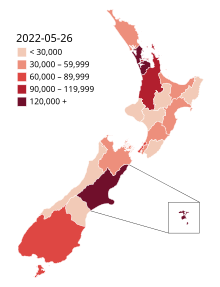COVID-19 pandemic in New Zealand
The first case of COVID-19 in New Zealand during the 2019–20 COVID-19 pandemic was reported on 28 February 2020. As of 28 August 2021[update], the country has had a total of 3,464 cases, of which 551 are currently active, and 26 people have died from the virus.[1]
| COVID-19 pandemic in New Zealand | |
|---|---|
 Map of the outbreak in New Zealand by district health board | |
| Disease | COVID-19 |
| Virus strain | SARS-CoV-2 |
| Location | New Zealand |
| First outbreak | Auckland, Auckland Region |
| Index case | Auckland, Auckland Region |
| Arrival date | 28 February 2020 (4 years, 10 months and 3 days) |
| Confirmed cases | 3,108[1] (total) |
| Active cases | 551 |
| Suspected cases‡ | 356[1] (total) |
| Recovered | 2,887[1] |
Deaths | 26[1] |
| Government website | |
| www | |
| ‡Suspected cases have not been confirmed by laboratory tests as being due to this strain, although some other strains may have been ruled out. | |
Actions
changeAll borders and entry ports of New Zealand were closed to all non-residents at 11:59 pm on 19 March 2020, with returning citizens and residents being required to self-isolate. Since 10 April, all New Zealanders returning from overseas must go into two weeks of quarantine.
Response
changeA four-level alert level system was added on 21 March to manage the outbreak within New Zealand. At higher alert levels, these levels enforce higher restrictions on what services can operate and how the available services will operate.
On 16 March, Prime Minister Jacinda Ardern called for an end to public gatherings of more than 500 people and warned that the outbreak could lead to a recession greater than the 2008 global financial crisis.[2][3]
Cases
changeOn 4 March, a New Zealand woman in her 30s who had returned from northern Italy on 25 February was confirmed as the second case of the virus in New Zealand.[4]
On 1 April, 61 new cases (47 confirmed and 14 probable) were reported, bringing the total to 708 (647 confirmed and 61 probable).[5][6] That same day, it was reported that the Chatham Islands, which are part of New Zealand, were facing a food shortage due to panic buying.[7]
On 1 May, 3 new cases (all confirmed) were reported, bringing the total to 1,479 (1,132 confirmed and 347 probable), and 11 new recoveries were reported, bringing the total 1,252. Six people were in hospital.[8]
References
change- ↑ 1.0 1.1 1.2 1.3 1.4 "COVID-19 – current cases". Ministry of Health. 31 December 2024.
- ↑ Moir, Jo (16 March 2020). "Coronavirus: Uncertainty over details of mass gatherings ban and stimulus package". Radio New Zealand. Archived from the original on 17 March 2020. Retrieved 17 March 2020.
- ↑ Walls, Jason; Cheng, Derek (16 March 2020). "Coronavirus: Gatherings of more than 500 people should be cancelled – Ardern". The New Zealand Herald. Archived from the original on 16 March 2020. Retrieved 17 March 2020.
- ↑ "Second Case of COVID-19 Confirmed in NZ". Ministry of Health, New Zealand. 4 March 2020. Archived from the original on 4 March 2020. Retrieved 4 March 2020.
- ↑ "COVID-19 – current cases". Health.govt.nz. 1 April 2020. Archived from the original on 1 April 2020. Retrieved 29 March 2020.
- ↑ "Confirmed coronavirus cases rise by 61, bringing total to 708". 1 News. TVNZ. 1 April 2020. Archived from the original on 2 April 2020. Retrieved 1 April 2020.
- ↑ "Chatham Islands without vital food supplies after coronavirus panic buying in NZ". 1 News. 1 April 2020. Retrieved 1 April 2020.
- ↑ "COVID-19 – current cases". Health.govt.nz. New Zealand Government. 1 May 2020. Archived from the original on 1 May 2020. Retrieved 1 May 2020.
Other websites
changeMedia related to COVID-19 pandemic in New Zealand at Wikimedia Commons